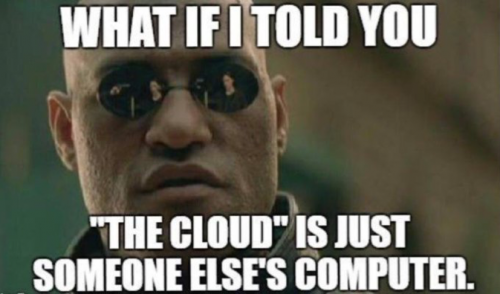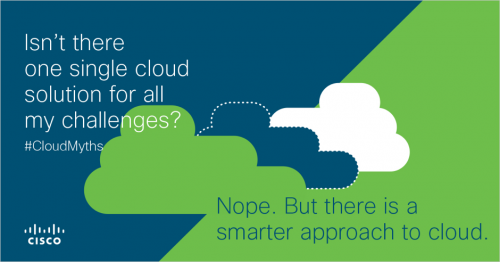
Unidentified Flying Objects, or unexplained aerial observations, have been reported throughout history.
The term ‘flying saucer’ wasn’t coined until 1947, when an amateur pilot in the US was misquoted in the press when he claimed he saw nine crescent-shaped objects flying through the air like “saucers skipping on water”.
Our fascination with UFOs and the existence of extra-terrestrial life goes back much further. From the tantalising carvings of‘spacemen’ made by the Maya, to the mysterious Nasca Lines of Peru, there are a number of ancient sites that some suggest prove our ancestors had close encounters with aliens.
Whether or not you believe in the existence of aliens and UFOs, there’s a more recent technology phenomenon that tends to evoke just as many myths and debate: the cloud.
Why would cloud computing be such a source of mystery and debate you may ask?
Surely everyone knows what cloud is about! …..right……?
………………………………………..
…so let us start with this cloud myth-busting exercise in celebration of this surely known to everyone and widely memorable day…
First thing’s first: there’s no such thing as “the cloud”.
FYI the image comes with an interestingly bitter response here
I know that these days the term ‘cloud’ is synonymous with “the Internet” (although let’s face it, it is much funkier). But “a cloud”, or “the cloud”, simply do not exist!
An interconnected network of clouds that belong to service providers, which they use for the delivery of services (a large proportion of them being publicly accessible or web-facing ones), well, that’s probably a bit more accurate. However, technically, we couldn’t be sure to what extent this can replace “the internet”, as I am sure there will be some web or ftp server out there that’s still not virtualised and thus part of a scalable resource pool bla bla bla…
Ironically, it is this lovely bulletproof Internet Protocol that creates the illusion of singularity. But no, sorry. The world is made of multiple clouds for use, each one having their own tools and standards. That might bring complexity, but it also means capabilities to explore!
So, every time someone says “why don’t you put it on the cloud?” the expected question should be: “Excuse me, which cloud are we talking about here?” which also provides the opportunity to be included in this elite category of people that will respond to questions with questions. #answering_questions_with_questions_rulez
Which masterfully brings us to… Cloud is not a location.
Cloud Computing is a computing paradigm or a computing model, according to the bible of cloud, written by the ancient fathers of NIST.
It’s a digital transformation journey where organisations can modernise their use of technology and better align IT and business, the holy grail of Information Technology. In more mature cloud adoption strategies, it links with changes in people and process, rather than technology only (which is why there are vendors including Cisco that offer cloud advisory services).
So what does “moving to the cloud mean”?
A phrase that when used by X number of people can actually have X+Y number of meanings simultaneously, because you can safely assume at least one is confused but still using it.
- It might mean literally moving “legacy applications”, i.e. traditionally-developed applications to rented Virtual Machines (or virtual servers or virtual infrastructure) that can host them, on top of shared or dedicated infrastructure. Infrastructure as a Service, as we love to call it.Can all applications be moved to a cloud? No.
In fact, there are applications in High Performance Computing for example that cannot and should not even be virtualised.
- It can also mean building applications using platform tools (PaaS), where the required application components don’t live in VMs but are provided “as a service” commonly referred to as “microservices” or cloud-native development. This means you don’t need to carry the traditional software stack of a virtual or physical “server” to develop or run those applications – i.e. Operating System, firmware, libraries, etc. Another way of trimming this extra fat while still getting the benefit of packaging is via containers. That’s what the people want and it’s where the future is, minus of course the lock-in 😉
 Can all applications be re-written using PaaS? Potentially.
Can all applications be re-written using PaaS? Potentially.
Will we be younger than 96 to witness this? Perhaps.
However, for the future ones that can and your team will be building, well, this is the closest it gets to cloud-enabled digital transformation.
- Finally, “moving to the cloud” might also mean consuming software online via a browser or a light-weight app that sources its functionality online. For example, good old Software as a Service (SaaS) – e.g. gmail.com, office365, salesforce, WebEx, Spark et al. And let’s not forget the apps that we you we are bringing every day to the corporate network such as Facebook, Spotify, WhatsApp
and of course Tinder.
But software offered as a service can be a complimentary or management toolset for other software or even for a hardware device, such as security or analytics apps that effectively contribute to reducing the overall complexity of IT itself. This is what we loosely refer to as a Cloud-based or a Cloud-managed service, emphasising on the subscription aspect of cloud – ie consuming something as a service (XaaS).For example, the Operating System for your iPhone, one would argue, or the one of your TV box.
Similarly, your Meraki solution for your wifi or CloudCenter for managing the different cloud platforms you use.
Or DNA Center, part of the most Hollywood-like launch taglines in the history of IT.
Or Cloudlock to protect users and devices when they use other cloud apps etc.
Or Jasper
Or…In that sense, moving to the cloud relates to a capability or a process that someone else (or you) is managing using a centralised technology-based solution to more efficiently address a business need.
Finally, my all-time favorite… “I want to move my business to the cloud”

Technically, unless you have a hot air balloon large enough to fit all your employees and assets, let’s be honest, that’s not going to happen.
There is simply no vendor or cloud provider that can cater for everything. Even if you just started and you are using a suite of cloud apps (and you should!), you will need something to connect to that cloud. And then as you grow you might need customised apps or to build your own. And then potentially more network capabilities as you have more customers, partners, offices and employees etc.
All the above will go to different “clouds”.
If you think about it, moving an organisation to the cloud means basically mapping out all those individual business processes and requirements to online services offered in different clouds (or simply by different service providers).
The objective is to simply optimise your business and make better use of technology.
…which reminds me:
So yes, please go ahead and move to “the cloud”.
Just tell us what and which one you want to move to and we can help.
(In fact, we should trademark this statement, as I don’t think other vendors or service providers can really claim this 😀)




